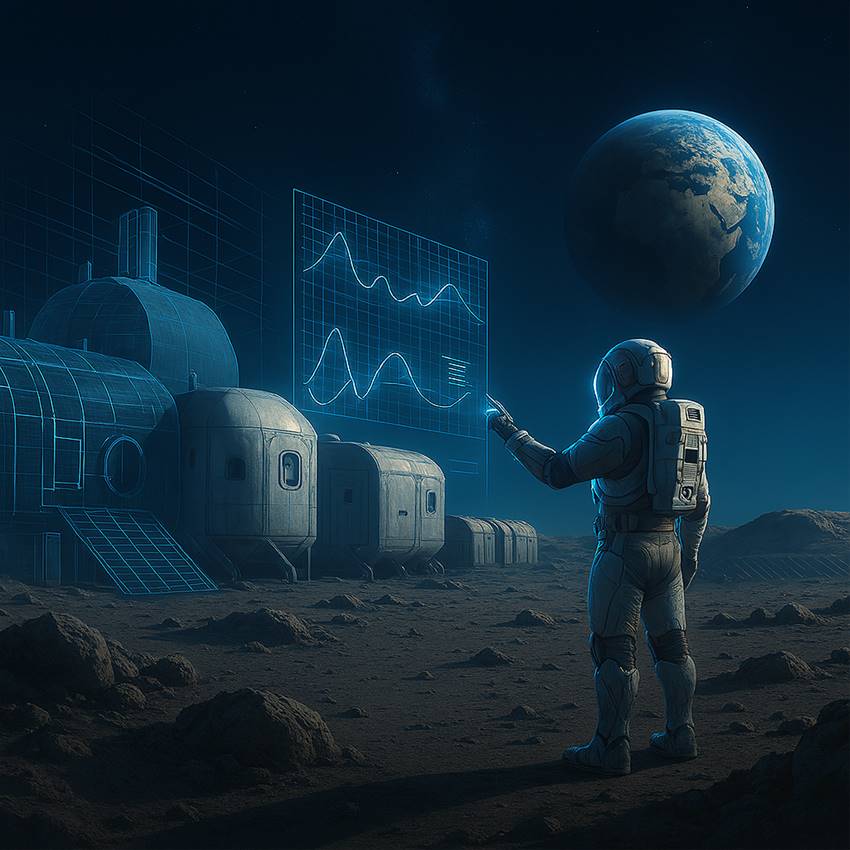
In the popular imagination, permanent lunar outposts still belong to science fiction, yet behind the scenes engineers and scientists are already building them—at least virtually. Modelling and numerical simulation (M&S) have become the key tools for turning a world we can’t yet touch into equations: lunar soil, the hyper‑rarified vacuum, and the electrostatic dust that coats everything.
For lunar‑system developers, M&S is no longer a mere aid to physical testing; it is the primary environment in which every decision is vetted before a single kilogram of hardware ever leaves Earth. By bringing reduced gravity, extreme vacuum, and fourteen‑day thermal cycles into software, teams can converge on optimal solutions in a fraction of the time and budget demanded by traditional test campaigns.
When thermal, structural, electrical, and control models all feed into a coherent digital twin, the team gains a dynamic view of the entire base ecosystem: pressurised habitats, logistics rovers, life‑support systems, and the telecom network interact in cycles that condense months of operations into a few hours of computation. Without assembling vacuum chambers that cost tens of millions of euros, they can check whether a cooling loop survives the lunar night, whether a photovoltaic array can tolerate electrostatically charged dust, or whether Ka‑band link latency stays acceptable when the orbiter enters eclipse. Each run returns curves, maps, and sensitivities that flow straight back into the design loop, cutting risk long before the production order is opened.
The same numerical infrastructure becomes critical once the base is installed. Telemetry from the habitat modules keeps the digital twin aligned with reality in near‑real‑time; divergences between model and measurement are parsed by predictive algorithms that catch performance drift before onboard alarms ever trigger. A bearing fouling with regolith, a battery degrading faster than expected, or an antenna losing pointing accuracy is flagged hours or days in advance, giving mission control time to schedule a corrective EVA or optimise load profiles to extend service life. In an environment where spare parts arrive only a couple of times a year, shifting from reactive to predictive maintenance is the difference between continuous operations and abort‑mission.
Simulation also becomes the lingua franca between disciplines. If the structural architect shifts a bulkhead to improve ergonomics, the radiation solver instantly recalculates cosmic‑dose exposure in the crew quarters; when the agronomist changes the greenhouse LED spectrum, the electrical‑network software updates the power budget. This instant feedback enables rapid iterations and reduces surprises during integration—traditionally the most expensive phase of the V‑cycle.
M&S then serves as a neutral testbed for materials, processes, and algorithms without risking flight hardware. In‑situ‑printed polymers, anti‑abrasion coatings, and cryogenic‑propellant reuse logics can be stressed in Monte Carlo campaigns, pushed beyond worst‑case scenarios, and folded back into the design only if they show concrete benefits. Private investors—ever more present in the space supply chain—also find in numerical models a familiar language for weighing risks and returns.
Looking beyond the Moon, the same M&S framework becomes reusable capital for missions to metal‑rich asteroids and for the first shipyards in Mars orbit. Boundary conditions—gravity, radiation, day length—change, but the logic does not: replicate in software what in hardware would be unique, experimental, and often irreparable. In this sense, simulation is the economy of scale for deep space, the only way to grow programmes beyond one‑off prototypes.
Ultimately, turning the vision of a lunar colony into a credible Gantt chart and a bankable contract portfolio requires perfectly integrated modelling and simulation environments. Every euro spent on CPU time and licences translates into mass savings, shorter integration schedules, higher reliability, and—above all—the ability to respond quickly to contingencies that, in deep space, offer no second chances





.png)